Aftershock Tremor: A compact DIY PC built for you
Convenience and upgradeability aren’t mutually exclusive
Not all PC gamers want to build their own systems, which is why they turn to pre-built, boutique models like the ASUS ROG G20AJ and the Alienware X51. These systems cost a pretty penny (they look pretty too), but are ready to go right out of the box and often come with comprehensive warranty and on-site support.
However, one gripe we have with such PCs is that they often come loaded with a lot of bloatware. It’s as if someone used your PC and installed a whole lot of their own programs on it. The manufacturer doesn’t quite let you forget that you bought the system from them, and for better or worse, they’re always there with you.
The Aftershock Tremor is a slightly different beast in the pre-built PC market. While the system still ships to you fully assembled, it has just your Windows operating system installed and contains no superfluous programs. This essentially means you also get more free hard drive space to work with. Furthermore, instead of being chock full of OEM parts, the Tremor houses consumer hardware that you could purchase yourself.
Many of the pre-assembled systems out there look good and are exceedingly convenient, but all this comes with certain trade-offs. Because these systems are often built with OEM parts and utilize non-standard cases and hardware, upgradeability is often limited.
As a result, the Tremor straddles the middle ground between committed system builders and gamers who wouldn’t go near the system assembly process with a 10-foot pole. If you want both convenience and the option to upgrade individual hardware components in the future, the Tremor is probably right up your alley.
Design
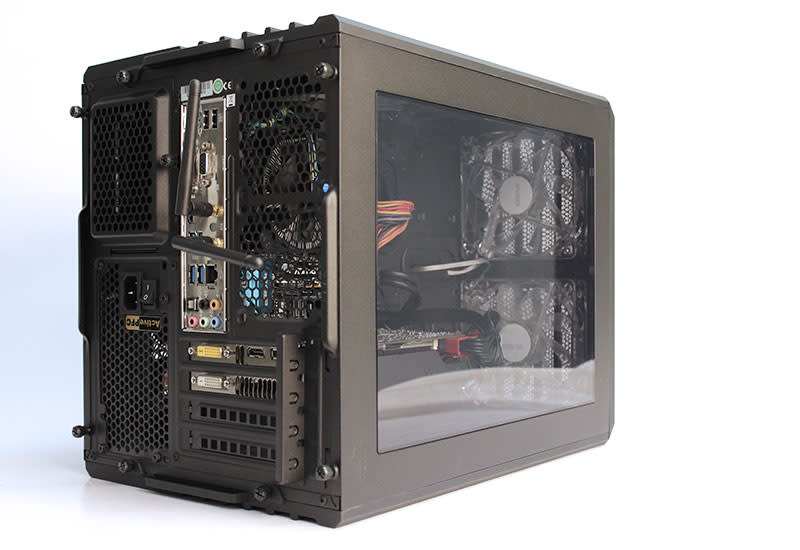
The Tremor uses the Corsair Carbide Air 240 micro-ATX and mini-ITX case, a small form factor windowed chassis that utilizes a dual-chamber design to separate your motherboard and graphics card from the hard drives and power supply. The original Corsair insignia on the front has also been subtly replaced with Aftershock’s own logo.
Our review unit came in brushed black, but Aftershock also offers it in Arctic White at no additional cost since it's also one of the default color options available from Corsair. But if you'd like something a little more fancy and unique, you can opt for a custom paint job by Modbot, with pricing subject to the nature of individual designs.
The front of the case is a sleek, minimalist facade. Half of it is taken up by the perforated fan vents that allow the two 120mm intake fans to draw air into the case. A series of raised ridges bifurcate the vents, effectively dispelling any accusations of plainness that could be leveled at the Tremor. The power and reset button, hard drive LED indicator, headphone jacks are located on the other half of the front panel, in addition to separate jacks for a headphone and microphone and two USB 3.0 ports.

Moving around to the back of the case, the Tremor sports four USB 3.0 ports, two USB 2.0 ports, and a PS/2 port for legacy peripherals. The rear I/O panel also features a Gigabit LAN port and five audio ports, the latter of which is handled by the onboard Realtek ALC892 audio codec. When it comes to display connectors, you’ll have your pick of a legacy D-Sub connector, DVI-D and HDMI. Wireless reception is handled by the two antennae on the motherboard’s rear I/O panel. These are screwed on and can be removed if you wish to rely on a wired LAN connection throughout.

However, you’ll probably be more interested in hooking up your display to the discrete Zotac GeForce GTX 970. The rear of the dual-slot card plays host to one DVI-D port, one DVI-I port, one HDMI port, and a single DisplayPort connector.

The case’s dual-chamber design also allows for neater cable management and better airflow to the CPU and graphics card, which definitely need more cooling than the storage drives and power supply in the rear compartment. Here's a look at the rear chamber and the tangle of cables that it hides from view:
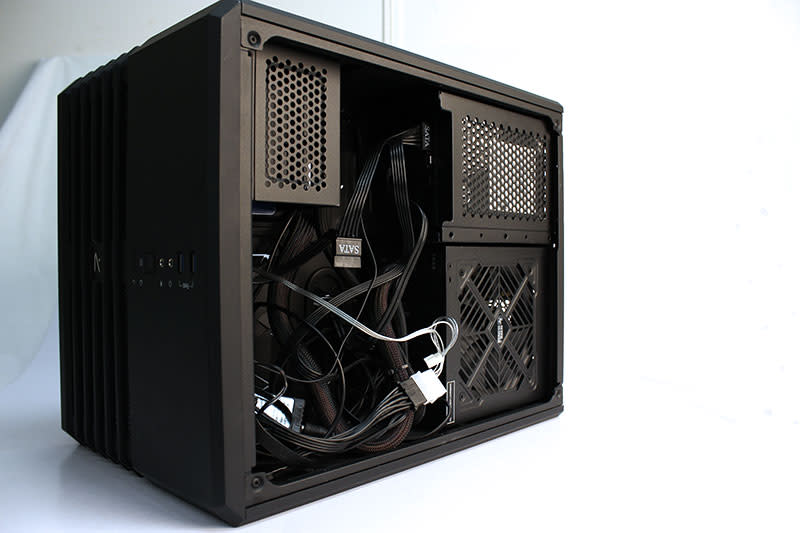
In the cooling department, the Tremor ships with two 120mm intake fans, in addition to a 120mm exhaust fan at the top. If you require additional cooling, the top of the case will accommodate one more 120mm fan. There’s also space for two rear 80mm fans, two 120mm fans at the bottom, and one more 120mm fan on the other side. These are nice options to have, but most users will probably not have much use for them.
Finally, for the least functional but most eye-catching feature of all - chassis lights. Aftershock lets you add on a multi-color custom remote lighting solution by Deepcool for S$40, and we have to say it's pretty snazzy. The lights are provided by an LED lighting strip that borders the windowed side panel so you get even lighting all around.

And the best part? You can customize the color you want from up to 15 different options, choose from a selection of lighting effects, and even adjust the brightness of the LEDs. With options for flashing or fading effects, the Tremor has some serious gaming cred going for it.
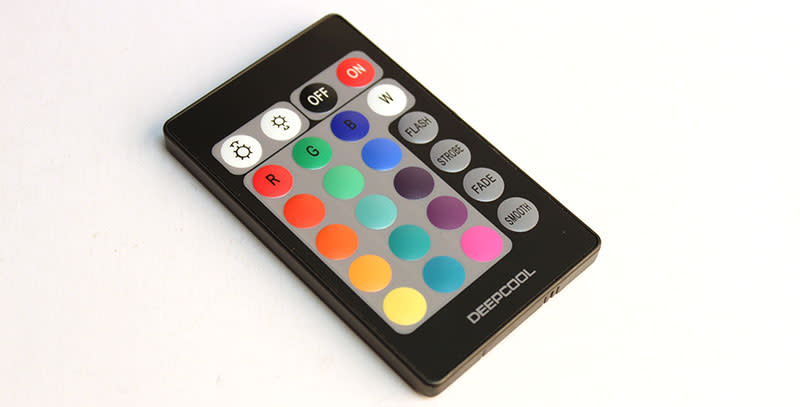
We also prefer this method of lighting control versus that on the ASUS ROG G20AJ, which requires you to enter the ASUS Command Utility to tweak the lighting effects. The remote allows you to cater to your every whim and fancy on-the-fly, and if you're feeling really capricious, you can go right ahead and switch up the lighting scheme in the middle of a game (no need to Alt-Tab at all)!
If we had to pick one thing to improve on, that would be the inclusion of custom uni-sleeved power supply cables. The current cabling is neat for sure, but it lacks a certain punch and ends up looking rather plain through the acrylic side panel window. Things liven up considerably when you turn the LEDs on, but uni-sleeved cables would still be an exceedingly nice touch.
Hardware
Our review unit of the Tremor features a quad-core Intel Core i7-4790 processor, which has a base frequency of 3.6GHz and boost frequency of 4.0GHz. Aftershock has paired this with an ASRock H97M-ITX/AC mini-ITX motherboard. And as we mentioned earlier, all the PSU cables can be routed to the second chamber behind the motherboard tray, which creates a really clean and neat front chamber with little to impede air flow.
As you can see from the below photo, there's also quite a bit of space toward the front of the case, which means you'll be able to fit a much longer GPU (up to 290mm) in there. NVIDIA GeForce GTX Titan X, anyone?
However, the mini-ITX form factor of the ASRock H97M-ITX/AC means that there is only a single PCIe 3.0 x16 slot at the bottom edge of the board. It looks like multi-GPU setups are out of the question here.
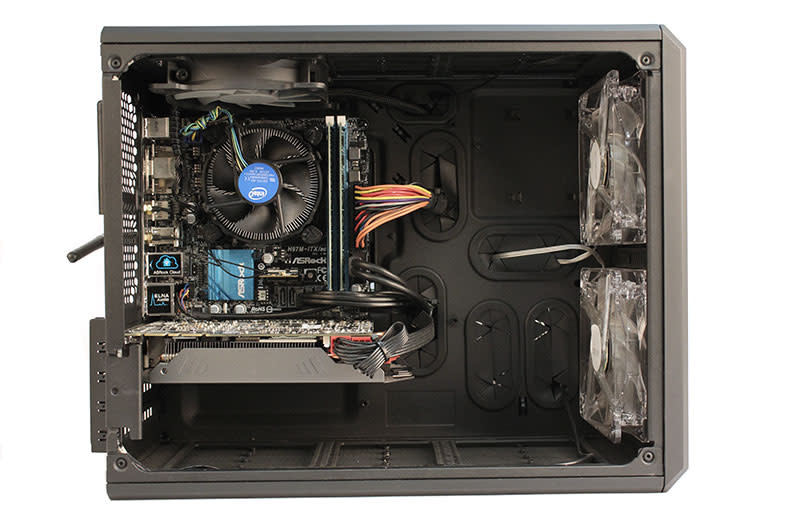
The ASRock motherboard also comes with a dedicated Wireless 802.11ac and Bluetooth 4.0 module, which connects to the two antennae located on the board’s rear I/O panel.
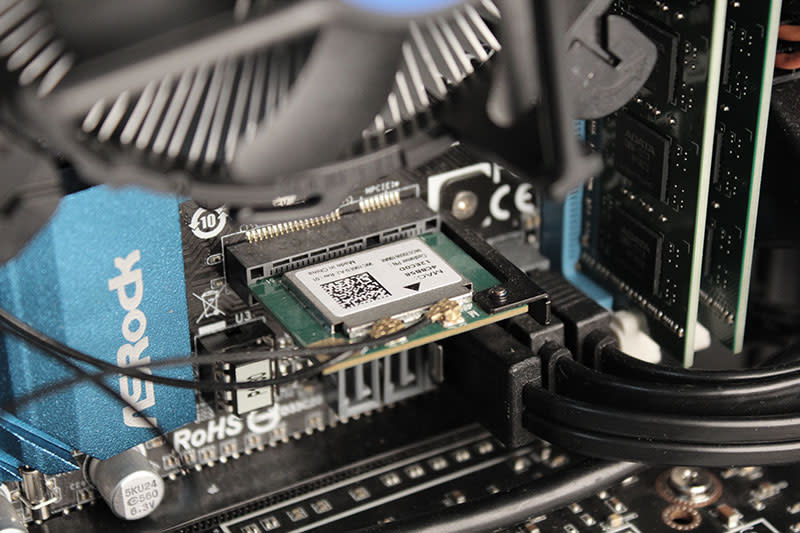
On the graphics side, the Tremor utilizes a Zotac GeForce GTX 970 card, which is actually a lot shorter than the full-sized NVIDIA GeForce GTX 970 reference card in the ASUS ROG G20.
Our unit also comes with 16GB of DDR3 1600MHz RAM, which should be plenty for both gaming and memory-hungry applications like photo editing.
The rear storage compartment behind the motherboard tray houses the storage drives. The Tremor comes with a 120GB OCZ Arc 100 OS drive and an additional 2TB Toshiba mechanical hard drive for storage. The 2.5-inch SSD sits toward the front of the chassis in its own tool-free drive cage. From the looks of it, there’s space for two more of such drives.

3.5-inch drives are installed at the rear of the case in their own tool-free bays. The chassis can accommodate up to three such hard drives.
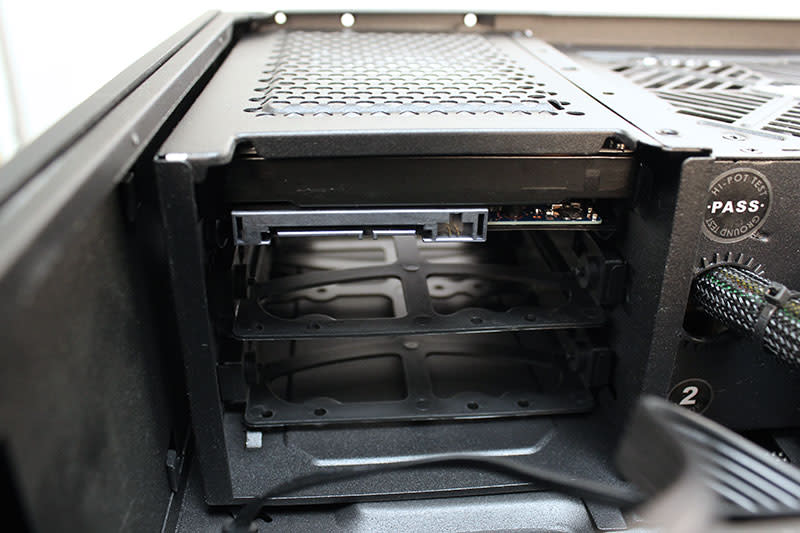
The power supply is a 600 watt Superflower model, which should supply enough power if you wish to get a slightly more powerful graphics card in the future.
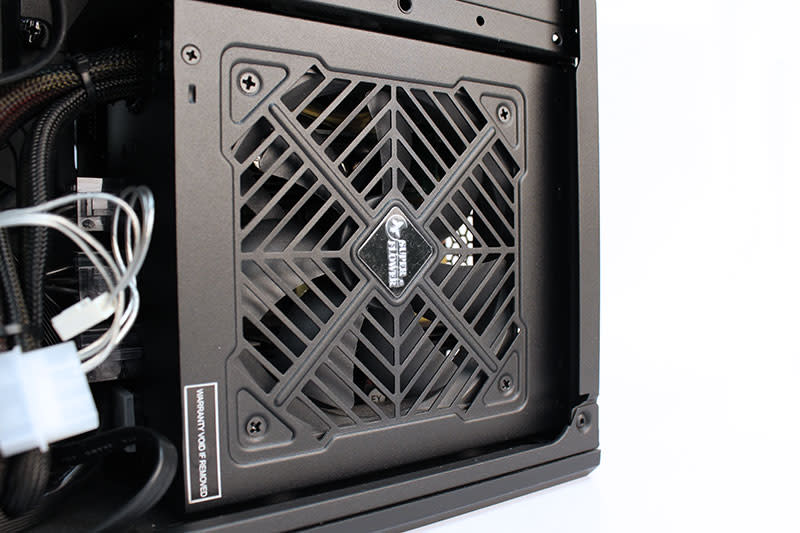
Test Setup and Performance
We’ll be putting the Aftershock Tremor through a series of synthetic and real-world gaming benchmarks to test its overall system performance and gaming capabilities.
As of now, we don’t have many similar desktop systems to compare it against, so we’ll just be pitting it against the ASUS ROG G20AJ and a few other high-end gaming notebooks. Even though it may seem that notebooks would make a poor comparison for a full-fledged desktop system, these notebooks are no featherweights and are actually intended to be desktop replacements.
As a result, they should provide a fair gauge of its performance. It is also fitting that these notebooks are targeted at a similar crowd that shies away from DIY systems, so the comparison should help consumers make a decision when it comes to choosing between a desktop system or high-end gaming laptop.
Here is a full list of the benchmarks used:
PCMark 8
3DMark 2013
Middle-earth: Shadow of Mordor
Tomb Raider
And before we dive into the results, here’s how the specifications of the Aftershock Tremor stack up against the compared systems:
|
|
|
|
|
|
|
|
|
|
|
|
|
|
|
|
|
|
|
|
|
|
— |
|
|
|
|
|
|
|
|
|
|
|
|
|
|
|
|
|
|
|
|
|
|
|
|
|
|
|
|
|
|
|
|
|
|
|
|
|
|
|
|
|
|
|
|
|
|
|
|
|
— |
|
| — |
— | — |
|
|
PCMark 8
PCMark 8 tests a system’s performance in areas like word processing, creative workloads, and web browsing. As expected, the two desktop systems inched out their notebook counterparts in most of the tests, although many of the latter put up a close fight.
However, even though the Tremor tops the scores in the Creative, Work and Home tests, there really isn’t a significant difference between it and the ASUS ROG G20AJ. This is actually to be expected, given that both systems sport the same processor and graphics card. The 120GB OCZ Arc 100 SSD on the Tremor was also barely 1% faster than the Kingston-branded SSD of the same size on the ROG G20, so it appears that both drives are equally matched as well.
Perhaps the most significant takeaway from our PCMark 8 test scores would be to show anyone who is thinking of doing serious photo editing and media transcoding that they will be much better off with a desktop system.

3DMark 2013
3DMark 2013’s Fire Strike benchmark renders at a resolution of 1080p and is used to test the single-GPU performance of PCs. The Aftershock Tremor was just over 3% faster than the ASUS ROG G20AJ, which could be attributed to the slightly higher base and boost clocks on the Zotac GeForce GTX 970 as compared to the ROG G20AJ’s reference card.
The Zotac card has a base clock of 1076MHz and boost clock of 1216MHz, versus the 1050MHz and 1178MHz on the reference card.
However, all the other systems were still handily put down by the Gigabyte Aorus X7 Pro, which features dual NVIDIA GeForce GTX 970M GPUs.

Tomb Raider
We observed a similar pattern in Tomb Raider, where the Aftershock Tremor beat the ASUS ROG G20AJ by a small margin thanks to its higher clocked GPU. Unsurprisingly, the dual NVIDIA GeForce GTX 970M GPUs on the Gigabyte Aorus X7 Pro again came out ahead here.
Short of dual-GPU solutions, it’s clear that the desktop graphics hardware is quite a bit faster than even the top-end mobile GPU, the NVIDIA GeForce GTX 980M. The Aftershock Tremor was almost 23% faster than the Aftershock W-15, and the mobile GPU simply can’t hold a candle to a full-fledged desktop component.

Middle-earth: Shadow of Mordor
Tomb Raider may not have told us anything we didn’t know, but the newer and more demanding Middle-earth: Shadow of Mordor should provide a better illustration of the performance you can expect from modern games. The Aftershock Tremor was the top performer at the High setting, topping both the ASUS ROG G20AJ and the Gigabyte Aorus X7 Pro by a small margin.
The dual-GPU setup on the Aorus faltered here, possibly due to its smaller memory bandwidth as compared to the desktop GeForce GTX 970. The mobile GPU has an available memory bandwidth of 120GB/s, whereas its desktop counterpart has more than double that at 224GB/s. Unlike 3DMark Fire Strike and Tomb Raider, Middle-earth: Shadow of Mordor demands quite a bit of video memory and bandwidth. As a result, the Aftershock Tremor was able to come out ahead of the pack, with the higher memory bandwidth and GPU clock speeds.
However, when it came to Ultra settings with HD Textures enabled, the Tremor again fell behind the Gigabyte Aorus X7 Pro. It seems that the GPU heft needed to render the game at Ultra settings simply outweighs any advantage in memory bandwidth a single GeForce GTX 970 might have, thus allowing the dual GeForce GTX 970Ms to edge ahead.

Conclusion
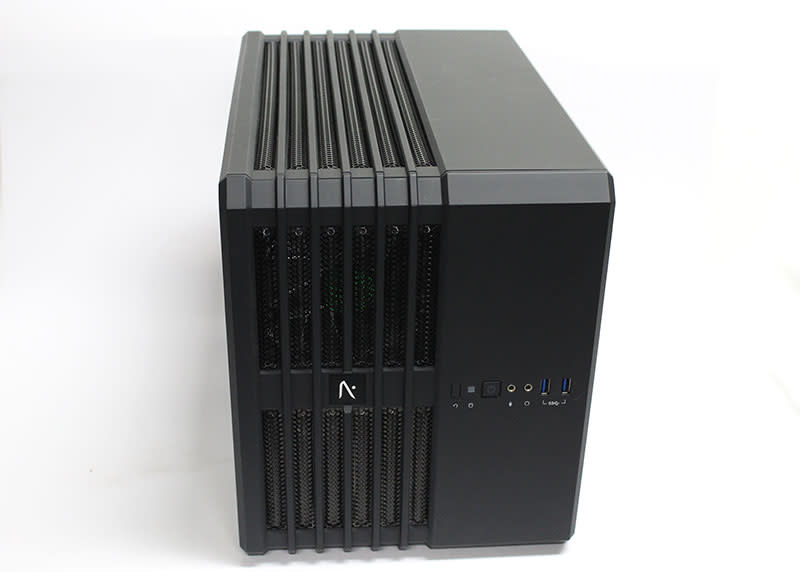
It’s difficult to judge the Aftershock Tremor as it stands alone. This is because it utilizes hardware components that can be sourced individually by consumers themselves, so an evaluation of the entire system would end up being a review of the merits of the discrete components. Even the Corsair Carbide Air 240 chassis that it uses can be bought off-the-shelf.
We thus feel more inclined to assess the Tremor based on the value it offers and how well Aftershock has curated the list of components for customers to choose from. To start matters off, we’ve compiled a table showing the price you’d pay if you assembled an equivalent system on your own with parts purchased separately (prices taken from PC Themes):
Component | Price (S$) |
|---|---|
ASRock H97M-ITX/AC + Intel Core i7-4790 | $598 |
Kingston Value RAM 2 x 8GB | $158 |
Zotac GeForce GTX 970 | $478 |
OCZ Arc 100 120GB | $88 |
Toshiba 2TB HDD | $97 |
Superflower Leadex 650W PSU | $149 |
Lite-on DVD-RW | $49 |
Corsair Carbide Air 240 | $139 |
Windows 8.1 Home 64-bit | $135 |
At S$1,891, a similar DIY system is around S$285 cheaper than the S$2,176 Aftershock is quoting for the system. However, do note that we weren’t able to find the specific Superflower 600 watt model, so we’ve instead gone for the next closest equivalent. We also haven't included the cost of a separate LED lighting solution.
For the additional cost, Aftershock puts the system together for you and delivers it right to your doorstep. It also offers a two-year parts warranty (one-year on-site) on the entire system. This means that Aftershock will make a trip down to your home to resolve any issues you may face, at least for the first year after your purchase. Many PC components are covered beyond Aftershock's two-year parts warranty, but you can still bring down the system to Aftershock's office for help on how to go about claiming warranty with the relevant distributors.
But if you’d like to enjoy a peace of mind and greater convenience for longer, the company is offering a three-year on-site warranty for an additional S$160.
If you’re a tinkerer in your own right and are confident in building your own system, it may seem gratuitous to shell out almost S$300 more for Aftershock’s services, and you are probably right. However, not everyone feels that way and there are plenty of customers who are afraid of the hassle that may come with PC assembly. Furthermore, because many of the distributors are located in out-of-the-way areas, you’d have to travel a fair distance - by Singapore’s standards - to resolve any hardware issues you encounter. And this is all assuming you have enough troubleshooting knowledge to identify the component that is giving you trouble in the first place.
It’s not difficult to see why users who are a little hesitant around hardware might appreciate paying a premium to be able to enlist Aftershock’s help on potential issues (and also save on making a trip down to the distributor’s office).
Furthermore, even after tacking on the additional S$160 for a three-year on-site warranty and bumping up the total price to S$2,336, the Aftershock Tremor is still cheaper than the S$2,699 ASUS ROG G20AJ, which also offers three years of on-site warranty but less freedom when it comes to upgrading. Of course, do note that the latter actually comes with a keyboard and mouse, an integrated Blu-ray combo drive, and doesn’t have a couple of not-so-subtle antennas sticking out of its derriere.
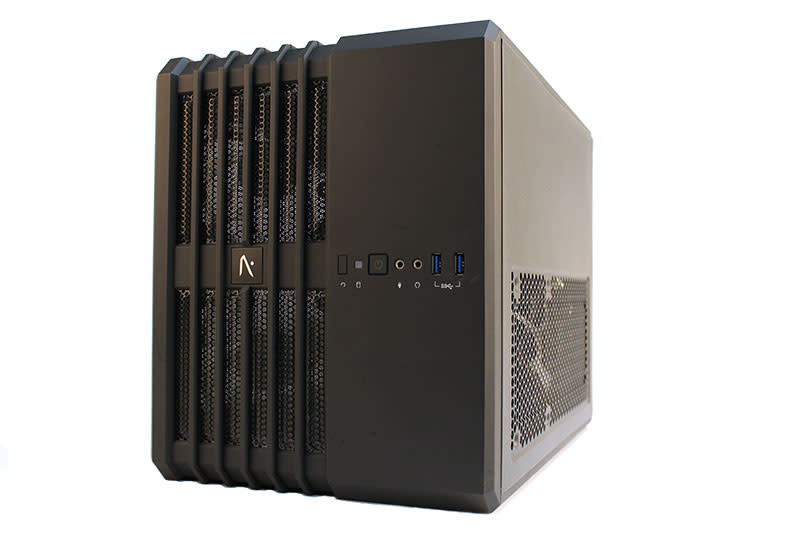
The Aftershock Tremor might be lacking a couple of niceties versus the ASUS ROG G20AJ, but we’d also like to go beyond our reviewed configuration and take a brief look into the other options that Aftershock is offering. Of particular note is the fact that you can opt for an ASRock Z97M Killer motherboard, which will support an overclockable CPU like the Intel Core i7-4790K. This Z97 board also comes with two PCIe 3.0 x16 slots, so it opens up the possibility of dual-GPU solutions. Furthermore, Aftershock isn’t limiting you to the compact size of the Corsair Carbide Air 240, and you can outfit your Tremor with a NVIDIA GeForce GTX Titan X!
Compared to boutique systems like the ASUS ROG G20AJ, the Aftershock Tremor may feel a little more rough around the edges and less tightly put together, but that’s because of its DIY roots. At S$2,176, our configuration of the Tremor offers decent value without any extraneous features like a bundled keyboard and mouse, Blu-ray drive, or unnecessary software that bog down your OS. Not to mention, the slightly higher clocked Zotac GeForce GTX 970 manages to outperform the NVIDIA GeForce GTX 970 reference card by a small margin.
For folks who want a more gentle introduction to the DIY market and the ability to outfit their system with the most powerful components, the Tremor is a good place to start.



